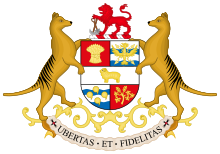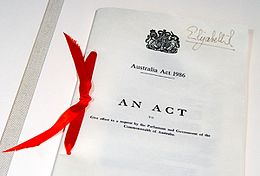
The Statute of Westminster 1931 is an act of the Parliament of the United Kingdom that sets the basis for the relationship between the Dominions and the Crown.

The Australia Act 1986 is the short title of each of a pair of separate but related pieces of legislation: one an act of the Parliament of Australia, the other an act of the Parliament of the United Kingdom. In Australia they are referred to, respectively, as the Australia Act 1986 (Cth) and the Australia Act 1986 (UK). These nearly identical Acts were passed by the two parliaments, because of uncertainty as to whether the Commonwealth Parliament alone had the ultimate authority to do so. They were enacted using legislative powers conferred by enabling Acts passed by the parliaments of every Australian state. The Acts came into effect simultaneously, on 3 March 1986.
Each Australian state has a governor to represent Australia's monarch within it. The governors are the nominal chief executives of the states, performing the same constitutional and ceremonial functions at the state level as does the governor-general of Australia at the national or federal level. In practice, with notable exceptions the governors are generally required by convention to act on the advice of the state premiers or the other members of a state's cabinet.
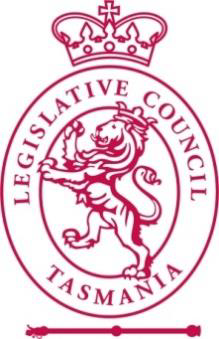
The Tasmanian Legislative Council is the upper house of the Parliament of Tasmania in Australia. It is one of the two chambers of the Parliament, the other being the House of Assembly. Both houses sit in Parliament House in the state capital, Hobart. Members of the Legislative Council are often referred to as MLCs.

The Parliament of Tasmania is the bicameral legislature of the Australian state of Tasmania. It follows a Westminster-derived parliamentary system and consists of the governor of Tasmania, the Tasmanian House of Assembly, and Tasmanian Legislative Council. Since 1841, both Houses have met in Parliament House, Hobart. The Parliament of Tasmania first met in 1856.
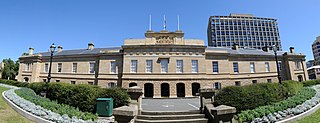
Parliament House, Hobart, located on Salamanca Place in Hobart, Tasmania, Australia, is the meeting place of the Parliament of Tasmania. The building was originally designed as a customs house but changed use in 1841 when Tasmania achieved self-government. The building served both purposes from 1841 to 1904, when the customs offices were relocated.

The states and territories are the second level of government of Australia. The states are administrative divisions that are self-governing polities that are partly sovereign, having ceded some sovereign rights to the federal government. They have their own constitutions, legislatures, executive governments, judiciaries and law enforcement agencies that administer and deliver public policies and programs. Territories can be autonomous and administer local policies and programs much like the states in practice, but are still legally subordinate to the federal government.

The monarchy of Australia is a key component of Australia's form of government, embodied by the Australian sovereign and head of state. The Australian monarchy is a constitutional one, modelled on the Westminster system of parliamentary government, while incorporating features unique to the constitution of Australia.
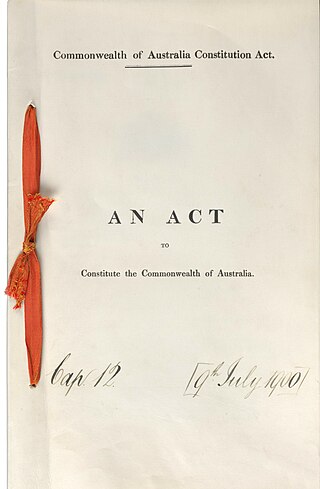
The Constitution of Australia is the supreme law of Australia. It is a written constitution that sets down the political structure of Australia as a federation under a constitutional monarchy governed with a parliamentary system and outlines the structure and powers of the Commonwealth of Australia's three constituent parts: the executive, legislature, and judiciary.
The Constitutional history of Australia is the history of Australia's foundational legal principles. Australia's legal origins as a nation state began in the colonial era, with the reception of English law and the lack of any regard to existing Indigenous legal structures. As the colonies expanded, Australia gradually began to achieve de facto independence. Over the years as a result the foundations of the Australian legal system gradually began to shift. This culminated in the Australia Act, an act formally ending legal ties with the UK.

The Colony of Tasmania was a British colony that existed on the island of Tasmania from 1856 until 1901, when it federated together with the five other Australian colonies to form the Commonwealth of Australia. The possibility of the colony was established when the Parliament of the United Kingdom passed the Australian Constitutions Act in 1850, granting the right of legislative power to each of the six Australian colonies. The Legislative Council of Van Diemen's Land drafted a new constitution which they passed in 1854, and it was given royal assent by Queen Victoria in 1855. Later in that year the Privy Council approved the colony changing its name from "Van Diemen's Land" to "Tasmania", and in 1856, the newly elected bicameral parliament of Tasmania sat for the first time, establishing Tasmania as a self-governing colony of the British Empire. Tasmania was often referred to as one of the "most British" colonies of the Empire.
A dominion was any of several largely self-governing countries of the British Empire. Progressing from colonies, their degrees of self-governance increased unevenly over the late 19th century through the 1930s, and some vestiges of empire lasted in some areas into the late 20th century. With the evolution of the British Empire into the Commonwealth of Nations, the dominions became independent states, either as commonwealth republics or commonwealth realms.
The royal prerogative is a body of customary authority, privilege, and immunity recognized in common law as belonging to the sovereign, and which have become widely vested in the government. It is the means by which some of the executive powers of government, possessed by and vested in a monarch with regard to the process of governance of the state, are carried out.

The principles of the current Constitution of South Australia, also known as the South Australian Constitution, which includes the rules and procedures for the government of the State of South Australia, are set out in the Constitution Act 1934. Its long title is "An Act to provide for the Constitution of the State; and for other purposes".

Section 58 of the Constitution Act, 1867 is a provision of the Constitution of Canada creating the office of provincial lieutenant governors, and providing for appointment by the Governor General of Canada.

Section 25 of the Constitution Act, 1867 is a repealed provision of the Constitution of Canada relating to the appointment of the first members of the Senate of Canada in 1867.

Section 127 of the Constitution Act, 1867 was a provision of the Constitution of Canada relating to the appointment of the first senators in the Senate of Canada. It outlined how members of the existing provincial Legislative Councils could be appointed to the Senate.

Section 128 of the Constitution Act, 1867 is a provision of the Constitution of Canada relating to the oath of allegiance for members of the Senate and the House of Commons of Canada, as well as members of the provincial legislative assemblies. The section also requires members of the Senate to make a declaration of qualification. The texts of the oath and the declaration of qualification are set out in the Fifth Schedule of the Act. The section also applied to members of the provincial legislative councils, but since they have all been abolished, it no longer has any application in that regard.

Section 56 of the Constitution Act, 1867 is a provision of the Constitution of Canada which previously set out the power of the British government to disallow laws passed by the Parliament of Canada. This power was only used once and no longer exists. The British government gave up the power as a result of the Balfour Declaration, which recognised Canada and the other British Dominions as equals of the United Kingdom.

Section 90 of the Constitution Act, 1867 is a provision of the Constitution of Canada relating to provincial appropriation and taxation bills, the recommendation for money votes in provincial legislative assemblies, and the federal government's power of disallowance and reservation with respect to provincial laws.
